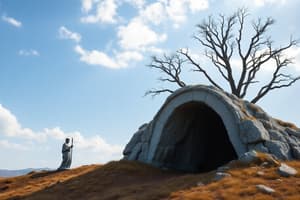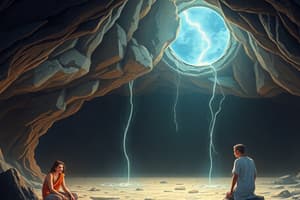Podcast
Questions and Answers
What is the purpose of the low wall behind which people walk in the cave?
What is the purpose of the low wall behind which people walk in the cave?
- To block the prisoners' view of the fire
- To prevent the prisoners from seeing the people walking behind them (correct)
- To create shadows of the objects on the cave wall
- To amplify the sounds of the people talking
What do the prisoners believe is the source of the sounds they hear?
What do the prisoners believe is the source of the sounds they hear?
- The people talking behind the wall
- The shadows on the cave wall (correct)
- Their own voices
- The objects being carried behind them
Why does the freed prisoner initially disbelieve what he is seeing when he is shown the 'real' world?
Why does the freed prisoner initially disbelieve what he is seeing when he is shown the 'real' world?
- Because his eyes are hurt by the light (correct)
- Because he is confused by the shadows
- Because he is sad to leave the cave
- Because he is scared of the fire
What do the prisoners consider to be their reality?
What do the prisoners consider to be their reality?
What does the freed prisoner want to do when he is shown the 'real' world?
What does the freed prisoner want to do when he is shown the 'real' world?
What is the initial reaction of the prisoner when he is dragged out of the cave and into the sunlight?
What is the initial reaction of the prisoner when he is dragged out of the cave and into the sunlight?
What is the first thing the prisoner is able to see when his eyes begin to adjust to the sunlight?
What is the first thing the prisoner is able to see when his eyes begin to adjust to the sunlight?
What is the reason the prisoners remaining in the cave would not want to undertake a similar journey to the freed prisoner?
What is the reason the prisoners remaining in the cave would not want to undertake a similar journey to the freed prisoner?
What is the ultimate goal of the freed prisoner in relation to the other prisoners remaining in the cave?
What is the ultimate goal of the freed prisoner in relation to the other prisoners remaining in the cave?
What happens to the freed prisoner's eyes when he returns to the cave?
What happens to the freed prisoner's eyes when he returns to the cave?
Flashcards are hidden until you start studying
Study Notes
The Cave Allegory
- Prisoners in a cave are chained to face the wall, unable to see anything else, and have been in this state since childhood.
- Behind the prisoners, a fire is burning, and people walk along a raised walkway, carrying objects or puppets that cast shadows on the wall.
- The prisoners believe the shadows are reality, as they have never seen anything else.
Departure from the Cave
- A freed prisoner is initially unable to see the objects casting the shadows due to the brightness of the fire.
- The freed prisoner would be reluctant to believe that the shadows are not reality, and would prefer to return to the familiar shadows.
- The freed prisoner would experience pain and discomfort when exposed to the light of the fire.
Ascent to the Surface
- The freed prisoner is forced to ascend to the surface, where they are initially blinded by the sunlight.
- The prisoner's eyes gradually adjust to the light, allowing them to see shadows, reflections, and eventually the people and things themselves.
- The prisoner is eventually able to look directly at the sun and reason about it.
Return to the Cave
- The freed prisoner returns to the cave, attempting to enlighten the remaining prisoners.
- The freed prisoner is blinded again upon returning to the cave, as their eyes are no longer accustomed to the darkness.
- The remaining prisoners infer that the journey out of the cave had harmed the freed prisoner, and would therefore resist any attempts to free them.
- The prisoners would even kill anyone who tried to drag them out of the cave.
Studying That Suits You
Use AI to generate personalized quizzes and flashcards to suit your learning preferences.




